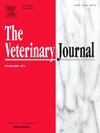A novel Gaussia luciferase immunoprecipitation assay for the detection of Getah virus antibodies in pigs
IF 3.1
2区 农林科学
Q1 VETERINARY SCIENCES
引用次数: 0
Abstract
Getah virus (GETV), a mosquito-borne pathogen, causes fever, aseptic meningitis, and abortion across various animal species, including pigs, horses, and cattle. Its widespread prevalence in China has resulted in substantial economic losses to the pig industry and poses a growing threat to public health security. Currently, no effective vaccine or antiviral drug for GETV control in China underscores the urgent need for the development of a rapid and sensitive antibody detection method for large-scale screening. In this study, we established a luciferase immunoprecipitation system (LIPS) assay to detect GETV antibodies in pig serum, utilizing Gaussia luciferase (GLuc)-tagged E2 as a diagnostic antigen. After optimizing the reaction conditions for the GLuc-E2-based LIPS assay, we determined the optimal GLuc-E2 input to be 10^7 luminance units and the optimal serum dilution to be 1:100, achieving the highest P/N ratio. Using 106 GETV-positive and 325 GETV-negative pig serum samples, the cutoff value for the S/N ratio was determined to be 13.71, yielding 99.69 % specificity and 100 % sensitivity. This LIPS assay showed no cross-reactivity with antibodies against other major porcine pathogens, including African swine fever virus (ASFV), porcine reproductive and respiratory syndrome virus (PRRSV), Japanese encephalitis virus (JEV), pseudorabies virus (PRV), and porcine circovirus type 2 (PCV2). Furthermore, a seroprevalence surveillance of porcine GETV in Hebei Province, China, validated the utility of this GLuc-E2-based LIPS assay for the diagnosis of GETV infection. In conclusion, we have developed a LIPS assay for GETV antibody detection, which could serve as a reliable tool for GETV detection in both laboratory and field settings.
一种用于猪Getah病毒抗体检测的新型高斯荧光素酶免疫沉淀法。
Getah病毒(GETV)是一种蚊媒病原体,可在包括猪、马和牛在内的各种动物中引起发烧、无菌性脑膜炎和流产。该病在中国的广泛流行给养猪业造成了巨大的经济损失,并对公共卫生安全构成越来越大的威胁。目前,中国还没有有效的疫苗或抗病毒药物来控制GETV,因此迫切需要开发一种快速灵敏的抗体检测方法进行大规模筛选。在本研究中,我们建立了荧光素酶免疫沉淀系统(LIPS)检测猪血清中GETV抗体的方法,以gauss荧光素酶(GLuc)标记的E2作为诊断抗原。在优化了以葡萄糖- e2为基础的LIPS实验的反应条件后,我们确定葡萄糖- e2的最佳输入为10^7亮度单位,最佳血清稀释为1:100,获得最高的P/N比。使用106份getv阳性猪血清和325份getv阴性猪血清,确定了S/N比的截止值为13.71,特异性为99.69%,灵敏度为100%。该LIPS检测结果显示,与其他主要猪病原体抗体无交叉反应性,包括非洲猪瘟病毒(ASFV)、猪繁殖与呼吸综合征病毒(PRRSV)、日本脑炎病毒(JEV)、伪狂犬病病毒(PRV)和猪圆环病毒2型(PCV2)。此外,中国河北省猪GETV的血清监测结果验证了这种基于葡萄糖- e2的LIPS检测方法在GETV感染诊断中的实用性。总之,我们开发了一种用于GETV抗体检测的LIPS检测方法,可作为实验室和现场环境中GETV检测的可靠工具。
本文章由计算机程序翻译,如有差异,请以英文原文为准。
求助全文
约1分钟内获得全文
求助全文
来源期刊

Veterinary journal
农林科学-兽医学
CiteScore
4.10
自引率
4.50%
发文量
79
审稿时长
40 days
期刊介绍:
The Veterinary Journal (established 1875) publishes worldwide contributions on all aspects of veterinary science and its related subjects. It provides regular book reviews and a short communications section. The journal regularly commissions topical reviews and commentaries on features of major importance. Research areas include infectious diseases, applied biochemistry, parasitology, endocrinology, microbiology, immunology, pathology, pharmacology, physiology, molecular biology, immunogenetics, surgery, ophthalmology, dermatology and oncology.
 求助内容:
求助内容: 应助结果提醒方式:
应助结果提醒方式:


